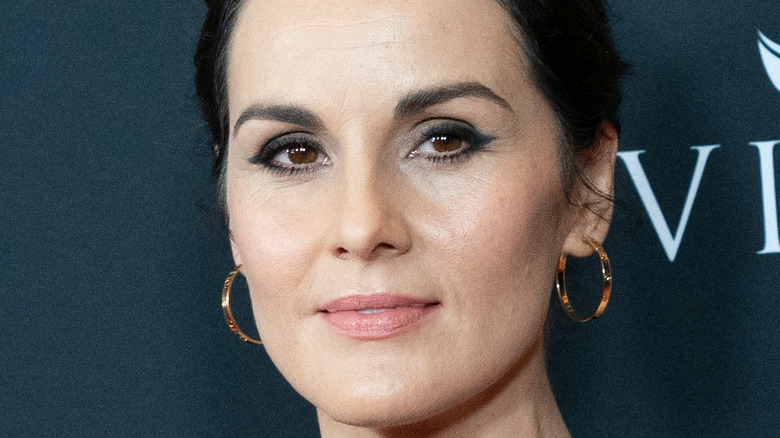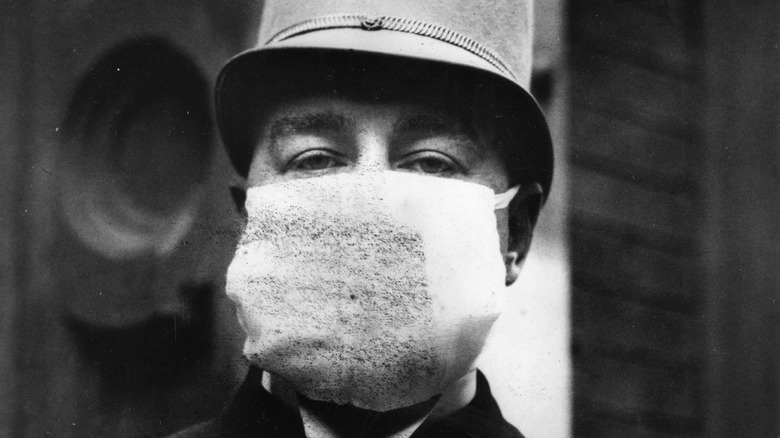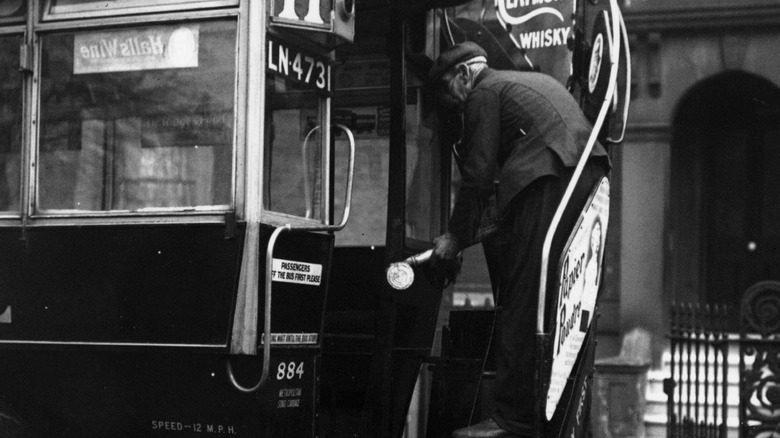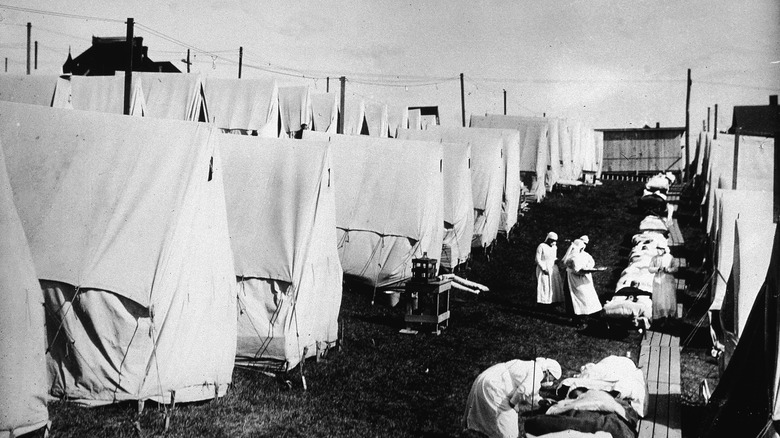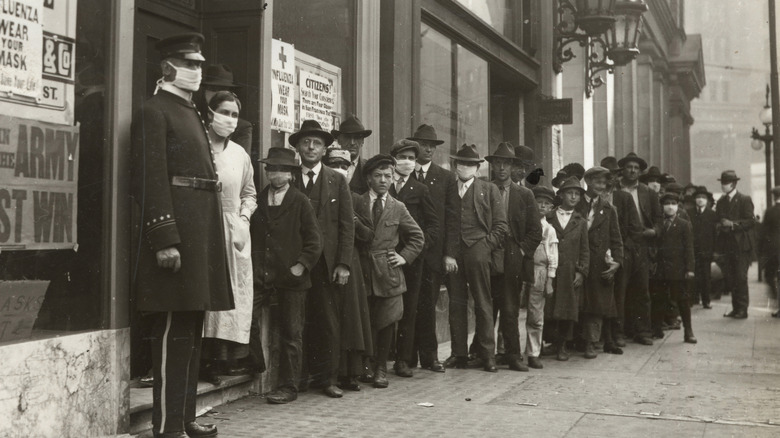How Downton Abbey Completely Botched Its Depiction Of The Spanish Flu
On May 20, "Downton Abbey" — a popular TV series that captured a transformative period in English history (via IMDb) — returns to the big screen with "Downton Abbey: a New Era," the second film adaptation based on the show, per Focus Features. This time, the story (starring Michelle Dockery, pictured) checks back in with the aristocratic Crawley family and their lovable servants near the end of the 1920s, just prior to the Great Depression.
Alongside drama and plenty of romance, the fictional TV series and the first film adaptation cover many notable historic events, such as the sinking of the Titanic and World War I. Few turn to "Downton Abbey" for a history lesson, but one major historical event from the period, the Spanish flu outbreak of 1918-1919, was not well represented. Here are a few things "Downton Abbey" got right, and a few things the show got very wrong, about the worst pandemic in modern history (per Centers for Disease Control and Prevention – CDC).
What was the Spanish Flu?
Caused by the H1N1 virus and of avian origin, the so-called Spanish flu pandemic broke out worldwide in the aftermath of World War I. Spread of the virus was worsened as troops returned home from the front. The virus came to be called Spanish Flu not because it started within that country, but because Spain was hard hit, and the Spanish media did not suppress the full scope and scale of the outbreak as media outlets in other countries did, according to the Nieman Foundation.
To this day, it's not known for sure just where or how the Spanish flu first got started. Nonetheless, an estimated 20 million to 40 million people died in the outbreak, which spread to every corner of the globe. An estimated 500 million people were infected, with younger generations especially susceptible to infection and mortality. That's a unique and defining characteristic of this severe flu outbreak that swept through England around the same time that "Downton Abbey" takes place (via CDC).
What was the Spanish Flu like in England?
Like many other places around the world, England was not immune to the Spanish flu outbreak. By 1918, the English population was badly affected, in no small part due to English troops returning from France post-World War I. The most serious symptom of Spanish flu was a sudden and spiking fever (per Cleveland Clinic). Like other countries, England downplayed the severity of the flu early on so as not to affect the wartime morale both at home and abroad. This only worsened the spread, according to Historic UK.
Even the English Prime Minister, David Lloyd George, caught it, although he survived. By the time the pandemic subsided in the U.K., roughly 230,000 people in England had died over roughly two years, a greater death toll than the Black Death outbreak that gripped the country in the 14th century. During this period, English hospitals were pushed to their limit, with no vaccine and few effective treatments to limit the spread or to minimize the suffering (via Historic UK).
Downton Abbey got some things right about the pandemic
When "Downton Abbey" finally addressed the Spanish flu in season 2 of the series, it did represent some things accurately, as far as what life was like in the U.K. during the outbreak. First was the timing, as three waves of flu overtook England during the period. One came in 1919, when the show's sophomore season takes place, including its episode about the Spanish flu. Quite likely, though, the Crawley family and their manor house would have been affected much earlier, according to Minneapolis online news outlet MinnPost.
The Spanish flu could also kill quickly, which is another thing "Downton Abbey" gets right. The only character in the show to die from the flu, Lavinia Swire (played by Zoe Boyle above) is dead in a matter of hours. According to University of Minnesota's Center for Infectious Disease Research and Policy's Michael Osterholm (speaking to MinnPost) that could happen. Although many deaths from the Spanish flu took several days, Osterholm said, "there were also deaths that took place within 24 hours."
The flu affected far more young people than the show represents
In one other small way, "Downton Abbey" got something right about the Spanish flu: Swire, the only character in the show to die from the flu, was young, and the Spanish flu outbreak was particularly lethal and especially contagious among younger people. The problem being, there are many young characters on the show, and it's highly unlikely that all those young people would have escaped uninfected, as the show represents. Mortality rates were high in flu cases as young as 5. Among the most affected demographics of all were those in the 20–40-year-old age range, per CDC.
As infectious disease expert Michael Osterholm told MinnPost, "The median age of death was in the mid-20s." One way the characters might have saved themselves from infection might be face masks, but no face masks are shown in the episode. Like the COVID-19 pandemic, wearing face masks during the Spanish flu was widely recommended and in some places enforced, but then, as now, it was controversial, as Health Affairs notes.
People were much more scared of the flu in 1919
The biggest point where Downton Abbey diverges from history as far as the Spanish flu is concerned is the overall fear, uncertainty, and anxiety the outbreak caused among the British population, infected or otherwise. By 1919, government suppression of just how severe the flu really was had ceased, and the seriousness of the situation was widely known at the time in which the "Downton Abbey" Spanish flu episode is set.
Layer that on top of the ongoing trauma and readjustment of soldiers who'd only just returned from the front. As epidemiologist with the Minnesota Department of Health, Richard Danila, told MinnPost, "[I]t's concerning to hear that no one [in the episode]] was afraid, because people were very afraid at the time ... It really was a major event in modern human history ... Outside of wars, there weren't many events seen like it. So to downplay it at all is wrong," Danila added (via MinnPost).
